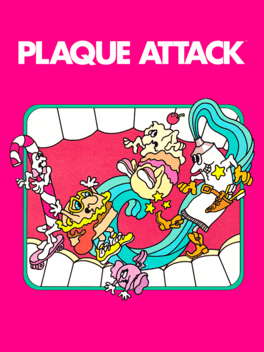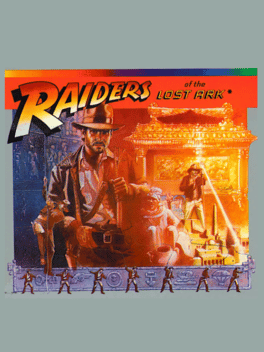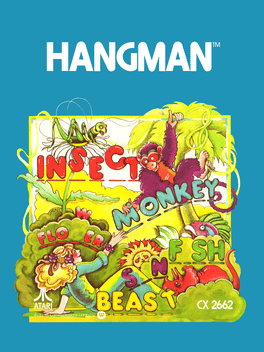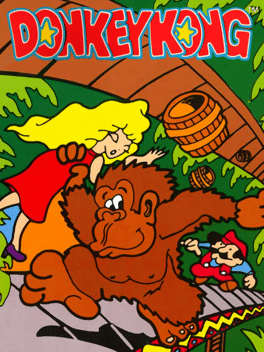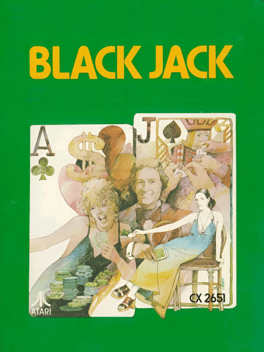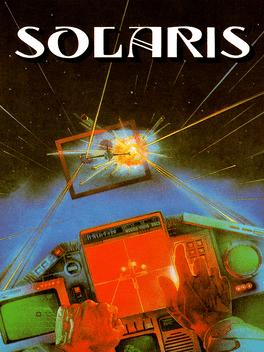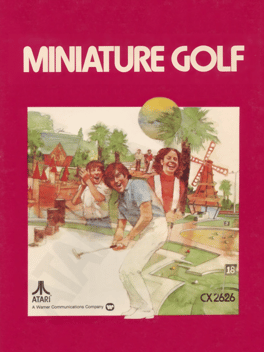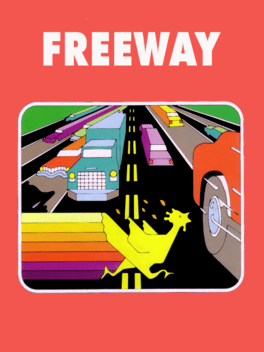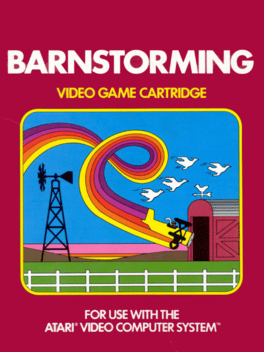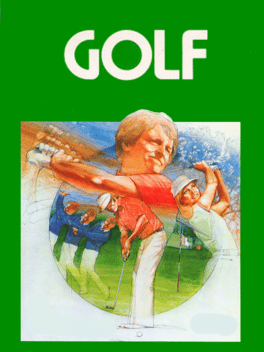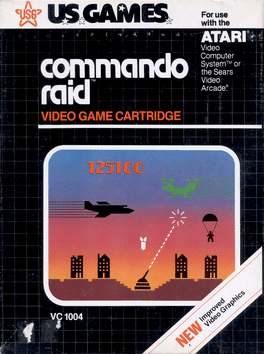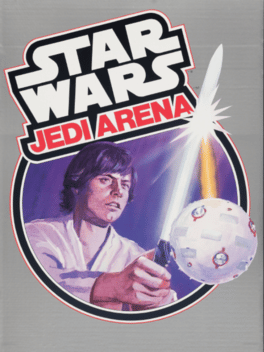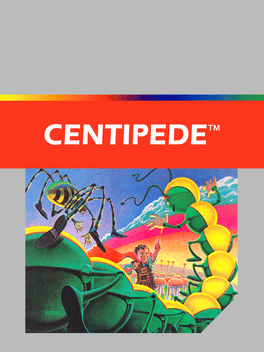Most Popular Atari 2600 Games - Page 2
-
Asteroids
1981
Asteroids
1981
star 6.1Asteroids for the Atari 2600 is a port of the arcade space shooter released in November 1979. The player controls a spaceship in an asteroid field which is periodically traversed by flying saucers. The objective of the game is to destroy both, asteroids and saucers. The triangular ship can rotate left and right, fire shots straight forward, and thrust forward. Once the ship begins moving in a direction, it will continue in that direction for a time without player intervention unless the player applies thrust in a different direction. The ship eventually comes to a stop when not thrusting. The player can also send the ship into hyperspace, causing it to disappear and reappear in a random location on the screen, at the risk of self-destructing or appearing on top of an asteroid. -
Plaque Attack
1983
Plaque Attack
1983
star 5.7Plaque Attack is a 1983 video game for the Atari 2600 that was made by Activision. Loosely based on Space Invaders, the player must prevent food from destroying teeth in a person's mouth. Steve Cartwright, who designed the game, said that game was meant to help people develop good dental habits. -
Chopper Command
1982
Chopper Command
1982
star 6.6Chopper Command is a video game by Activision released for the Atari 2600 in June 1982. It was designed and programmed by Bob Whitehead. In Chopper Command the player controls a military helicopter in a desert scenario protecting a convoy of trucks. The goal is to destroy all enemy fighter jets and helicopters that attack the player's helicopter and the friendly trucks traveling below, ending the current wave. The game ends when the player loses all of his or her lives or reaches 999,999 points. A radar, called a Long Range Scanner in the instruction manual, shows all enemies, including those not visible on the main screen. A player who achieved 10,000 points could send in a photo of the TV screen and receive a "Chopper Commandos" patch. -
Bowling
1979
Bowling
1979
star 5.3The game is based on the game of bowling, playable by one player or two players alternating. In all six variations, games last for 10 frames, or turns. At the start of each frame, the current player is given two chances to roll a bowling ball down an alley in an attempt to knock down as many of the ten bowling pins as possible. The bowler (on the left side of the screen) may move up and down his end of the alley to aim before releasing the ball. In four of the game's six variations, the ball can be steered before it hits the pins. Knocking down every pin on the first shot is a strike, while knocking every pin down in both shots is a spare. The player's score is determined by the number of pins knocked down in all 10 frames, as well as the number of strikes and spares acquired. -
Surround
1977
Surround
1977
star 6.2Surround was an unofficial port of the arcade game Blockade, released the previous year by Gremlin. As such, it was the first home console version of the game that would become widely known on other platforms as Snake. As with other early Atari games, it was licensed to Sears, which released it under the name Chase. The cartridge was subdivided into 14 different games. The first 12 of these were variations on the Blockade theme. Like its predecessor Blockade and successor Snake, the object of Surround was to maneuver a sprite across the screen, leaving a trail behind. A player wins by forcing the other player to crash into one of the trails. Various options allowed for speed-up, diagonal movement, wrap-around and "erase" (the choice to not draw at a given moment); in addition, the sprites could be set to operate at a beginning "slow" speed, or progressively speed up through five speeds. -
Hangman
1978
Hangman
1978
star 4.4Hangman was one of the eleven Atari 2600 titles that were part of the second wave of games released in 1978. It is based on the old words guessing game played with paper and pen. The player must guess which letters compose a word. Every wrong guess adds to the diagram of a man being hung, or in the case of this game, a monkey hanging from a bar. Eleven wrong guesses ends the game. Games can be played as one or two player games, and different grade levels of words. Two players can even provide the words for one another. -
Demons to Diamonds
1982
Demons to Diamonds
1982
star 4.8Players attempt to shoot demons in a "cosmic carnival" and then pick up the diamonds left behind by them, while dodging shots from enemy skulls. The player operates a laser base at the bottom of a multi-row playfield, using the paddle controller to move it from side to side and the controller's action button to fire a laser beam vertically up the playfield. The player can control how far onto the playfield the beam advances by releasing the button at the desired height. The player receives one point for each demon and ten points for each diamond successfully shot. Points are multiplied by the distance from the base to the target. For example, a demon shot one row above the player is worth one point, while a demon shot four rows above the player is worth four points. In multiplayer mode, the second player operates a laser base at the top of the screen, firing from top to bottom. Again, the second player must shoot demons that match the color of its gun in order to produce diamonds. However, diamonds may be shot by -
Donkey Kong
1982
Donkey Kong
1982
star 7.1The Atari 2600 port of the hit arcade Donkey Kong differs from the original version in gameplay and has two stages instead of the original four. -
Blackjack
1977
Blackjack
1977
star 3.4Atari's Blackjack employs a variant of blackjack rules that is so extremely unfavorable to the player, that it would almost certainly never be seen in a real casino because no one would play with them. Splitting pairs is not allowed, and even more substantially, draws are won by the dealer (your bet is not returned to you if you and the dealer get the same card total and neither busts). This represents over a 10% house advantage. The player uses the paddle controller to enter a bet of up to 25 chips from an initial pot of 200. An up card is then presented, and the player decides whether to "hit" (accept another card) or stand. The player breaks the bank by obtaining a score of 1,000 chips, or is "busted" upon losing everything. Due to a glitch in the program, while a player is selecting among the options of what to do with the current hand by pressing left or right with the paddle controller, the amount of the player's next bet is modified even though it is defined by a variable that will not be visible until the -
Solaris
1986
Solaris
1986
star 5.1Solaris is a space combat game for the Atari 2600 published in 1986 by Atari Corporation. It was developed by Doug Neubauer, who owns the copyright and the Solaris trademark. The game is a sequel to Neubauer's Atari 8-bit family game Star Raiders from 1979. Both games feature an enemy race known as Zylons, but Star Raiders uses a first-person perspective while Solaris is in third-person. Solaris was at one point going to be based on The Last Starfighter, while the Atari 8-bit version of The Last Starfighter was renamed Star Raiders 2. -
Dolphin
1983
Dolphin
1983
star 5.4Listen! An endangered dolphin is calling you! Only by learning the dolphin's sonic language can you guide her through schools of seahorses, battling a monstrous squid, to gain magic powers from and elusive seagull. Hurry! Lend an ear... You will guide your dolphin through openings in the seahorse schools by listening to sonic tones and catching waves. Pay attention to the following: THE SEAGULL: Periodically, a seagull will fly overhead. You'll know he's coming when the squid changes color. Have your dolphin leap up, touch the seagull and then quickly turn and chase the squid. This is the best way to gain points. Also, the game resets at the next difficulty level putting distance between your dolphin and the squid. THE SLIP: Another great way to outsmart the squid is by giving him "the slip". If the squid is right on your tail, wait until he catches a good wave. Then, reverse your dolphin's direction and swim under him immediately. As long as the squid's good wave remains on the screen, he won't be able to rever -
Miniature Golf
1979
Miniature Golf
1979
star 4This is a computer game simulation of a miniature golf course. It attempts to refine your sense of timing and your perceptiveness in judging distance. As in a traditional miniature golf course, a variety of obstacles are placed in your path to the cup. Depending on the game that is selected, the course can be played solo, or a two player competition can be initiated. -
Freeway
1981
Freeway
1981
star 5.3Freeway is a video game designed by David Crane for the Atari 2600 video game console. It was published by Activision in 1981. One or two players control chickens who can be made to run across a ten lane highway filled with traffic in an effort to "get to the other side." Every time a chicken gets across a point is earned for that player. If hit by a car, a chicken is forced back either slightly, or pushed back to the bottom of the screen, depending on what difficulty the switch is set to. The winner of a two player game is the player who has scored the most points in the two minutes, sixteen seconds allotted. The chickens are only allowed to move up or down. A cluck sound is heard when a chicken is struck by a car. Comparisons are often made to Frogger, which has also features crossing a street filled with moving vehicles. Similarities did help sales when Frogger was popular in the arcades and a home version was not yet available. Freeway was made available on Microsoft's Game Room service for its Xbox 360 consol -
Barnstorming
1982
Barnstorming
1982
star 5.9The player must pilot a biplane through a series of barns in the shortest time possible while dodging windmills, weather vanes, and geese. Bumping into anything slows down the plane for a couple of seconds, increasing the overall time. There are four levels of play determined by the game select switch. Game 1 is Hedge Hopper (10 barns), game 2 is Crop Duster (15 barns), game 3 is Stunt Pilot (15 barns), and game 4 is Flying Ace (25 barns). In the first three games, the course layout of barns, windmills, and even geese do not change, making it easy to memorize the layout. Game 4 is the only game with a random course. -
Golf
1980
Golf
1980
star 4.3This game features a simplified type of golf. The area of the hole is rendered in light green, all areas outside the hole are rendered in a medium blue. On the larger holes the green is rendered as a dark green hole circle with the hole near the center. There are several obstacles that can appear, including trees, sand traps, and water features. On difficulty A, balls that go out of bounds stay there and must be hit back in; on difficulty B, the balls stick to the edge of the area. Balls hit near the water can soar over it, or if they land into the water, the ball is placed back where the shot was taken. Balls hit into sand traps will stick to the sides of the traps, and it takes a more powerful swing to free the ball. The player only uses one club - the amount of time the fire button is held down determines how much power the ball will be hit with, and how far it will go. The player's golfer can be moved anywhere on the field, with his golf club always facing the ball. On the larger hole the goal is to hit the bal -
Basic Math
1977
Basic Math
1977
star 3.4Basic Math (aka Fun With Numbers) is a video game cartridge developed by Atari for its Video Computer System (later known as the Atari 2600). The game was one of the nine launch titles offered when the Atari 2600 went on sale in September 1977. The player's objective is simple: solve basic arithmetic problems. Game variations determine whether the player solves addition, subtraction, multiplication, or division problems, and whether he/she could select the top number (the console randomly selects the lower number). The player uses the joystick to enter a guess, with sound effects signaling whether it is right or wrong. -
Commando Raid
1982
Commando Raid
1982
star 5.9You are in defense of your buildings which have come under attack by android commando raiders. Without warning they appear, intent on capturing your buildings and destroying your gun emplacement. First the troop carrying helicopters fly in dropping android paratroopers to test your defenses. Soon the sky is filled with fluttering helicopters and wave after wave of android paratroopers. They must be destroyed! Each paratrooper allowed to land on a building destroys a portion of that building. If three paratroopers land on a building. It will be totally destroyed and must be considered under commando control. Worse still, the androids can now tunnel towards your gun emplacement. Each paratrooper who lands on that building expands the tunnel. If they are not stopped, they will plant an explosive charge under the gun. In the midst of the battle, an aircraft may appear. It will drop a devastating bomb which can destroy all buildings and the gun emplacement. You must shoot it down or at least shoot the bomb it drops. -
Star Wars: Jedi Arena
1983
star 5.9In Jedi Arena, you have to face an opponent in the arena to see who is the true Jedi master. Wandering throughout the arena is a seeker which is capable of firing laser bolts. To be victorious you need to destroy your opponents shield by having the seeker fire laser bolts at it. You are armed only with a light saber which is used to control the direction of the laser bolts you fire, as well as block incoming fire from your opponent. The first player to break through the other players shield wins a point, and the first player to 3 points wins the match! Several game options are included which control the speed of the seeker, or even make the seeker invisible. -
Centipede
1983

